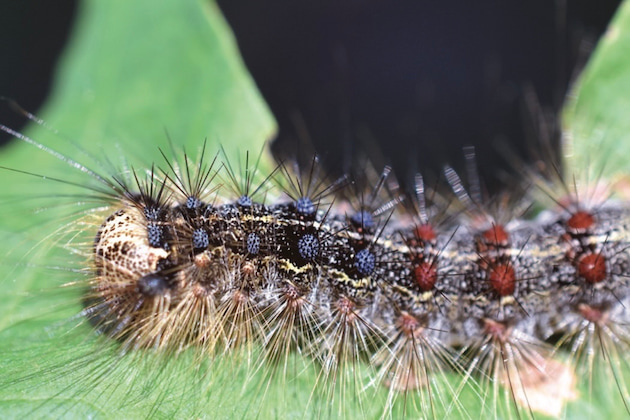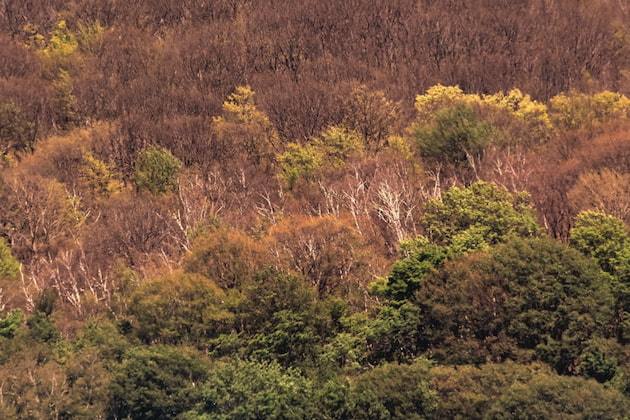Sugarbush Management
Caterpillars are back this summer, and hungry
Infestations reported in N.Y. and Vt.
By PAUL POST | JUNE 21, 2022
WEST CHAZY, N.Y.—They're back and they're hungry.
A widespread invasion of Lymantria dispar, previously called gypsy moths—now known as the more politically correct spongy moth—is expected to be larger than last year's infestation that impacted an area from Michigan to northern New York and Vermont.
The Vermont agenecy of agriculture said last week it has received numerous inquiries from concerned citizens regarding large numbers of spongy moth caterpillars.
Tiny caterpillars emerge in spring and devour many types of hardwood tree leaves and some evergreens, completely defoliating forests where outbreaks are most severe.
"Leaves are usually eaten soon enough in the year that trees will put out a new flush of leaves, but this takes energy away from the trees' stored pool of energy, the same energy source (sugars) we are pulling from during the maple season," said Adam Wild, director of Cornell University's Uihlein Maple Research Center in Lake Placid, N.Y.
"One year of defoliation will more than likely not kill the tree, but if the tree is already stressed it's going to add to the tree's demise. It could also impact our future maple production seasons," Wild said.
In Vermont, the Champlain Valley is the area most apt to be impacted again, said Mark Isselhardt, University of Vermont maple specialist. "
"They're seeing higher numbers of egg masses compared to last year," he said. "Last year it was fairly well contained to Addison and northern Rutland counties. We didn't see a whole lot of spillover to the eastern part of the Green Mountains. But things can happen. There may be some extending down to Southern Vermont."
The big question for sugarmakers is what, if anything, can be done about the voracious pests, which typically appear about every 15 years.
Outbreaks, like the current one, normally last two or three years until natural enemies such as a fungus, exacerbated by wet weather, or a type of wasp that can parasitize eggs, cause moth populations to crash.
Some maple producers with large tracts of land hire firms to apply a chemical spray aerially, which kills caterpillars as they ingest treated leaves.
But timing is critical as this strategy only works when caterpillars first emerge, usually in mid-May. They're no longer vulnerable after growing to a larger size, in June.
Isselhardt urged producers concerned about next year to enlist a forester, in late summer or autumn, to conduct an egg mass survey.
"That's the best way to predict how much potential there is for defoliation next year," he said.
"That is the time to start lining up someone to spray the following spring," Wild said. "You'll pay more money if you call in the spring and hope for someone to come spray the next week. You'll be lucky if you can even find someone who has availability at the last minute."
Lowville, N.Y.-based Duflo Spray Chemical Company is one of the roughly half-dozen aerial spray applicators in upstate New York. Owner Jeff Duflo said he alone got more than 400 requests for aerial spraying this spring.
"Timing is the most critical factor," he said. "You need 75-100 percent leaf development and larvae have to be migrating up trees and starting to feed on leaves. That's when the spray period begins."
Mike Parker had 600 acres sprayed last year at his 110,000-tap Parker Family Maple Farm in northeastern New York, and found it to be quite effective.
"We could see they were hatching during the third week of May and that it was going to be devastating, so we put in an emergency call, they came and sprayed and we have no egg clusters this year," he said.
"It was a solid investment for the future, but also the short term. We experienced the highest sugar content in years."
In contrast, fellow Clinton County, N.Y. producer Ben Dragoon didn't spray last year and said his sap's brix was noticeably lower this spring, about 1.6 when it's usually around 2.
"They literally stripped 90 percent of our 1,200 acres here," he said. "Toward the end they were even stripping the pines, hemlocks and cedars. They were in my hayfields, everywhere. It was bad. They hit the oaks real hard, which surround the sugarbushes. I don't know many years they can withstand being defoliated before they die."
However, spraying to prevent defoliation is good for the overall health of a sugarbush. "If the trees aren't having to use some of their stored energy to re-grow a new set of leaves, they're free to devote some of that to radial growth, which is adding more conductive wood, so the tree is healthier and becomes bigger, which increases sap production," Isselhardt said.
Associate Professor Dylan Parry, of State University of New York College of Environmental Science and Forestry, has done extensive spongy moth research. He's also on the New York Invasive Species Advisory Committee.
Warm, dry weather with temperatures in the low 80s got caterpillars off to a healthy, hungry start in May, but Mother Nature will play a key role in determining how severe the infestation becomes as summer unfolds, he said.
"Rainfall and humidity during the late caterpillar stages should lead to very high mortality, an epizootic-insect pathogen outbreak, which should lead to the collapse of most populations," Parry said. "Whether that happens or not is weather dependent and so pretty hard to predict."


































